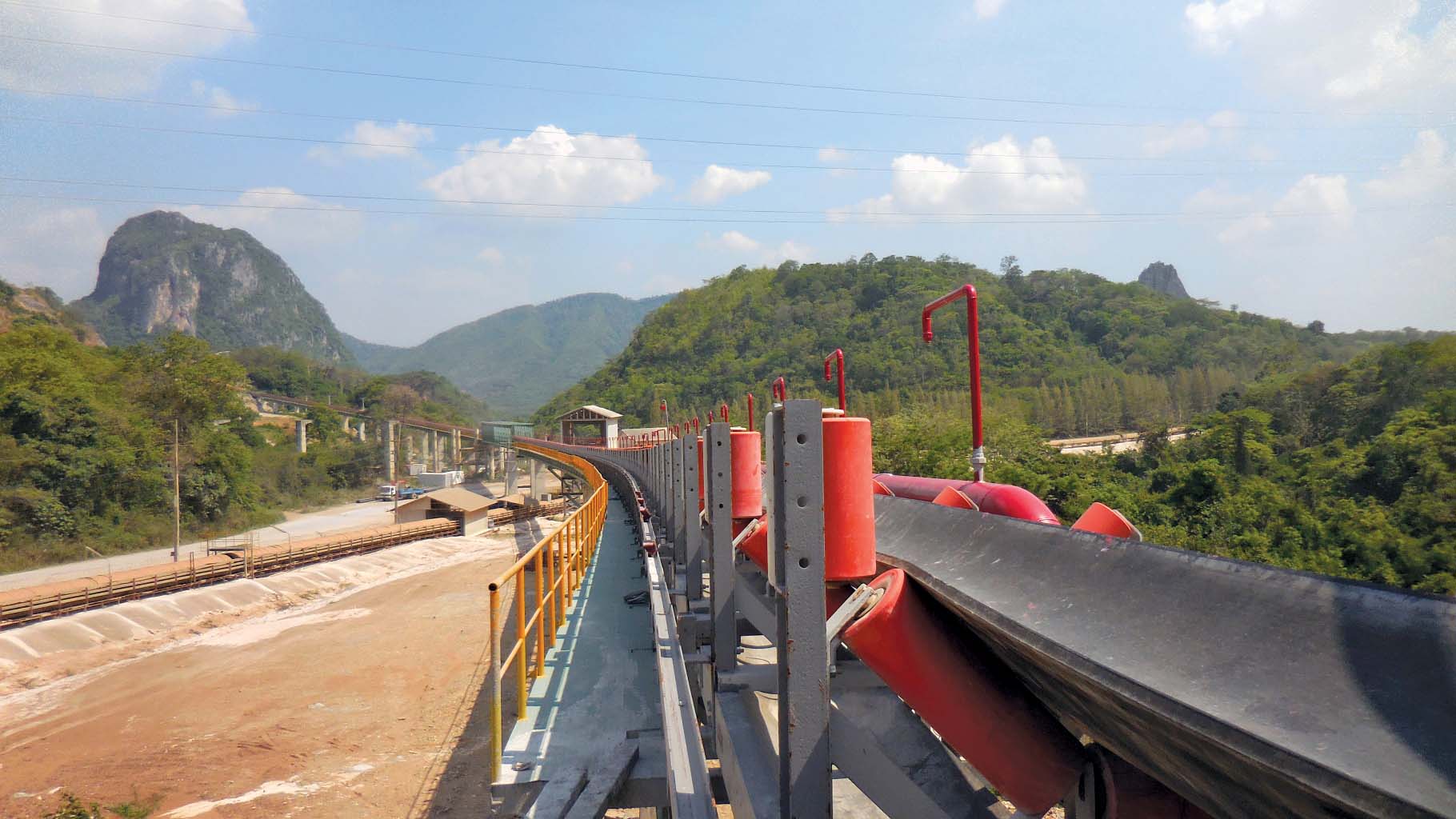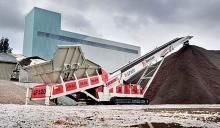
Conveyor, stockpiler and stacker manufacturers are focusing on how their solutions can enhance overall quarry operation productivity. Patrick Smith reports.
Today, many of the major quarrying equipment manufacturers offer systems for getting material from the quarry floor to crushers and screeners.
While conveyors, stockpilers and stackers have for a long time been a part of quarry operations, new designs and developments are improving their potential to boost productivity.
The high cost of fuel was one reason cited for more quarries considering using conveyors instead of the hauling option. But often logistics come into the equation as the
Among operators for whom it has successfully commissioned conveying plants is TPI Polene Public Company, the third largest cement producer in Thailand. Its system solution is used to transport crushed limestone from the quarry to the blending bed.
“The challenge lay in the nature of the ground between the quarry and the cement plant,” says Dr Andreas Echelmeyer, head of the CL Systems division.
“It was exceptionally demanding. We had to make allowances not only for numerous obstacles but also for a steep downhill section of the conveyor. The team designed a complex, but above all cost-effective, integrated system comprising a total of eight belt conveyors covering a distance of 6,129m. Beumer also supplied a PLC plant control system, transfer stations, filter systems and foreign body collectors.”
The key items in the system, designed with a conveying capacity of 2,200tonnes/hour, are two downhill belt conveyors followed by a troughed belt conveyor with horizontal curves.
Material passes from the crusher discharge belt to the first two troughed belt conveyors, and is then transferred to a long overland conveyor with a speed of 4.5m/second. Three more conveyors finally transport the material to the blending bed.
Beumer supplied four further belt systems with a total length of 989m to deal with the discharge from the blending bed and supply the material to the raw mill feed hopper.
Vietnamese cement producer, Cong Thanh, also relies on a solution from the Beumer Group to transport crushed limestone from quarry to blending bed.
A system consisting of four conveyors with a combined length of 3.5km is now in use. The main component, an overland conveyor with three horizontal curves, is designed for a continuous conveying capacity of 2,200tonnes/hour.
The heaped material is transported in trucks from the quarry face to the crusher. The limestone that has been pre-crushed to less than 100mm is then transferred by discharge conveyors to an accelerator belt that feeds the long belt conveyor.
Late last year,
The company says each of the new conveyors offer easy and low-cost transport costs, and can be shipped in one 40ft container, with track-in, track-out ability, eliminating crane costs and lengthy set-up times.
With 400mm dual speed tracks as standard, the AggreStac can be customised to suit various applications in various regions.
Terex AggreStac conveyors are also designed to easily integrate with existing electrical and hydraulic control systems on TWS equipment. Additionally, it removes the need for TWS customers to use third party suppliers of auxiliary equipment and provides high-quality, cost-effective stockpiling equipment to complement TWS’ full range of washing and screening equipment. This is said to make for more manageable and effective project management, installation and commissioning of one complete washing solution for the customer.
Other Terex companies offer similar equipment, with
Meanwhile,
“Telestack is one of the primary stalwarts of bulk material handling equipment. We are excited about the future and we have a comprehensive programme of company and product developments ahead of us,” says Malachy Gribben, commercial director.
Telestack recently globally launched a number of new and innovative models, including the AggStack range, a series of mobile conveying systems for the quarry, aggregate, sand and gravel markets. The series combines its range of entry level radial telescopic stackers; radial fixed length stacking conveyors; truck unloaders; hopper feeders, and link conveyors.
The company’s Aggregates and Mining division also unveiled enhancements to the Telestack hopper feeder range, which include the LF520 and the brand new LF520 Radial.
It says this low feeder range allows operators to directly discharge from wheeled loaders/grab cranes and excavators at a significantly lower feed in height compared to standard hopper feeders, while its HF1021R, from the Revolution series hopper feeder range offers centre-mounted slew bearing that enables 360° rotation of the hopper and boom. It is said to be ideal for barge and rail loading and unloading, and stockpiling.
The Revolution option is available on all HF/LF models.
A variety of Trackstack conveyors in conjunction with a large fleet of loading shovels are being used by Fergusson Coal to manage stockpiles.
After deciding to update its equipment, the company bought a number of new loading shovels and three Trackstack 8042T.
“Fergusson Coal has benefited greatly with the use of track conveyors as they have increased productivity and reduced the downtime required to move mobile equipment around site. They have also increased stockpile capacity with the minimised breakage and compaction of material and have greatly improved the consistency of material, making cleaner stockpiles and achieved less spillage around site with the reduction in loader shovel movement,” says the company.
Conveyor capacity is able to achieve up to 600tonnes/hour and for 300-400tonnes/hour requirements engine revs can be reduced down to 1,650rpm from the maximum 2,200rpm available, and this also reduces fuel consumption “dramatically.”
Meanwhile, Samson has announced a number of new products, including the evolution of the wheeled Stormajor boom feeder BF0415T to the tracked version.
“This concept delivers a cost-effective solution for stockpiling, barge loading, ship loading and rail wagon loading, even in the world’s most arduous conditions,” says the company.
It is designed to receive bulk materials with densities of up to 1.6tonnes/m³ direct from trucks providing a large holding capacity and a regulated output feed rate of up to 625m³/hour direct to the mobile crushing, screening or other processing plant.
However, as Swedish company
“Mineral extraction and processing creates large amounts of highly abrasive dust that can enter into machinery, mix with the lubricant inside, and cause accelerated wear and eventual failure of bearings, seals, gears, couplings and other rotating parts,” says the company.
“Conveyors operate at fairly low speed and under high loads and sometimes at high temperatures placing high demands on the bearings, seals and lubrication. Their remote location can also make maintenance and health monitoring difficult. Together, contamination and lubrication failures account for more than half of all bearing failures in mining applications.”
SKF says its offerings for belt conveyors cover the full asset life cycle, and include bearings, housings, seals, lubrication systems, maintenance solutions and reliability engineering.
For example, it says its Three-barrier solution is an environmentally friendly, cost-effective solution that is proven to extend service life of the conveyor pulleys.
“When installed, the solution provides the conveyor bearing with three layers of protection against contamination and greatly reduces the amount of lubrication required by up to 90%. This reduces maintenance costs.”
For extreme contaminated conditions, the SKF Three-barrier solution is combined with the new SKF Taconite seal to block contamination entering the housing, including high pressure water during maintenance.
“We refer to this as the ultimate SKF Three-barrier solution,” says Keith Meyers, SKF’s global industry manager mining, mineral processing and cement.









